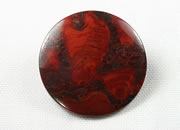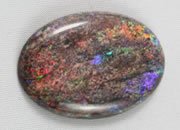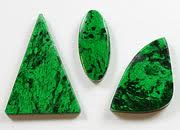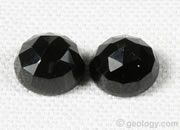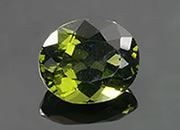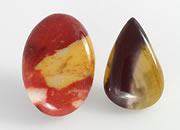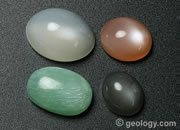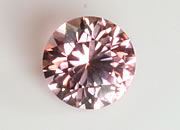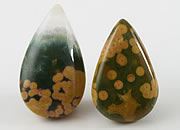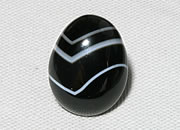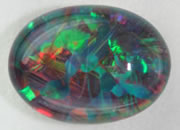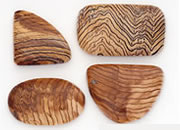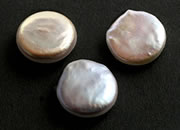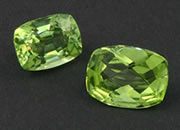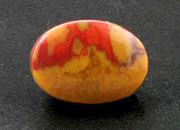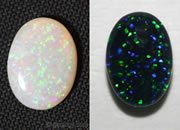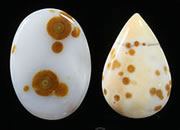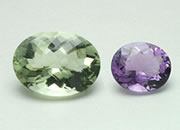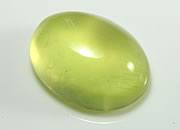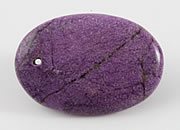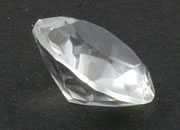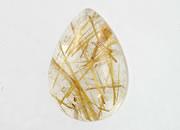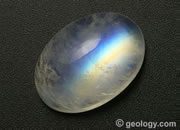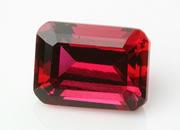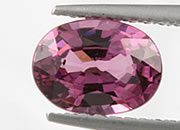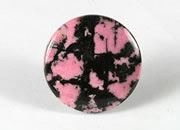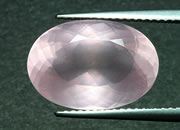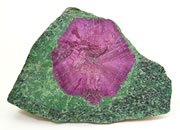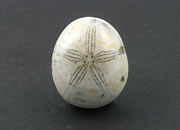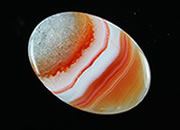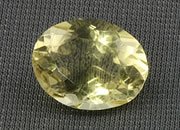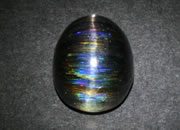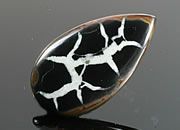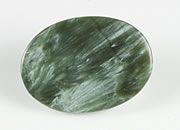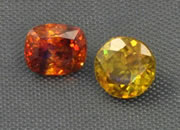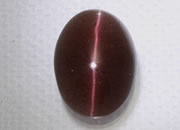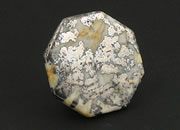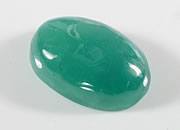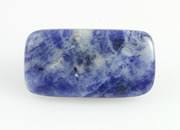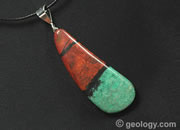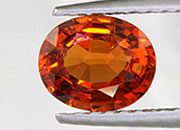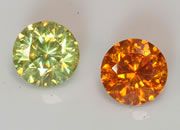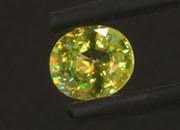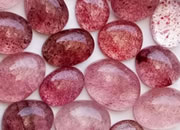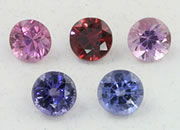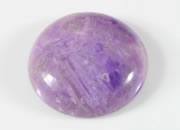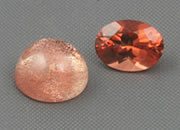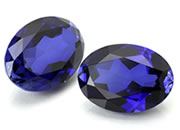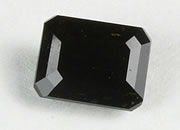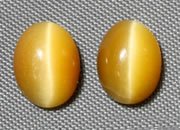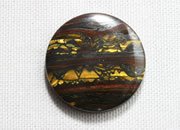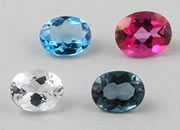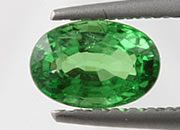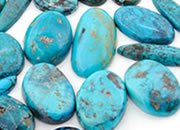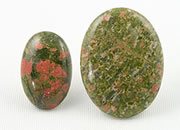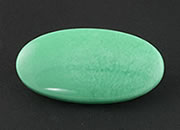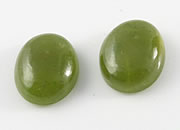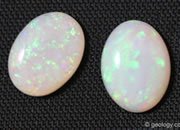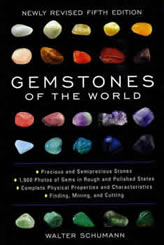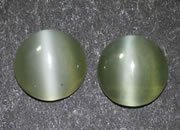 |
Actinolite (Cat's-Eye)
Actinolite is green to grayish green mineral of the amphibole group found in metamorphic rocks. It sometimes has a fibrous texture that produces a strong cat's-eye. |
|
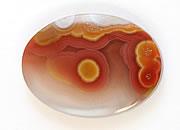 |
Agate is a cryptocrystalline quartz that is translucent and patterned with bands, plumes, dendrites, or inclusions that produce a colorful, interesting appearance. It is a popular gem cut into cabochons, beads, and ornamental objects. |
|
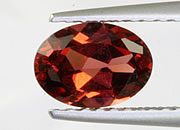 |
Almandine garnet, also known as "almandite," is an iron-rich, red-to-purple garnet that is geologically very common and typically sells on the more affordable side of the garnet price range. For that reason, it is common in jewelry. |
|
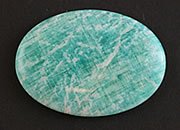 |
Amazonite is a trade name given to a light green to bright green variety of microcline feldspar. It has a Mohs hardness of 6 with perfect cleavage, so it is best used where it will not suffer abrasion or impact. |
|
 |
Amber is a fossil resin secreted by ancient trees. It usually has a yellowish to orangish brown color but can be white, greenish, bluish, or black. It is an organic gem easily cut and polished into bright, lightweight gems. |
|
 |
Amethyst is a transparent variety of quartz that ranges from light lilac to deep purple in color. It is one of the most popular faceted gemstones and is sometimes cut en cabochon. It is found in many locations around the world. |
|
 |
Ametrine is a bicolor quartz that is half AMEthyst and half ciTRINE. The color combination is caused by twinning. It is commercially produced at only one mine in the world, located in eastern Bolivia. |
|
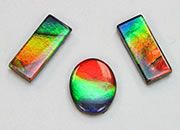 |
Ammolite is a trade name used for iridescent ammonite shell. It produces a bright flash of color that rivals opal and labradorite. All of the world's production of this organic gem is from a small area in Alberta, Canada. |
|
 |
Ammonite
An extinct group of marine invertebrate animals that produced a chambered shell. Their fossilized shells are often cut and used as organic gems. |
|
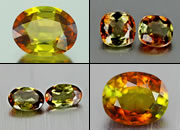 |
Andalusite is a metamorphic mineral that is strongly pleochroic and an underappreciated gem. A variety known as chiastolite has grains of graphite concentrated into a cross-shaped feature. |
|
|
ADVERTISEMENT
|
|
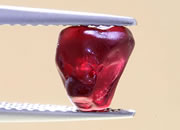 |
Ant hill garnet is a novelty gem that ants excavate, haul to the surface and deposit on their ant hill. These red chrome pyrope garnets are often found on ant hills in parts of the southwestern USA. |
|
 |
Apatite is a mineral that is cut as a gem when found in clear crystals with attractive colors. It has a hardness of 5 on the Mohs scale and is brittle. It is a "collector's gem" rather than a jewelry gem. |
|
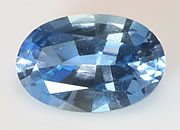 |
Aquamarine is a blue variety of the mineral beryl. It receives its name from its seawater color. It ranges from a very light blue to a richly saturated blue. The richer color is much more desired. |
|
 |
Aventurine is a quartz variety that contains a blizzard of tiny reflective inclusions such as muscovite, hematite, or fuchsite. Light enters the stone, reflects from the grains and produces a flash known as aventurescence. |
|
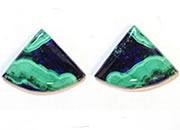 |
A beautiful dark blue opaque gem material found near copper deposits. Associated with malachite and chrysocolla; soft (H: 3.5-4); cleaves easily. Best used as cabochons in jewelry that will not encounter wear. |
|
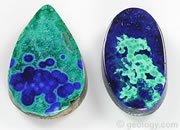 |
A beautiful blue and green gem material that is a combination of the copper minerals, azurite and malachite. It is soft and chips easily. It is cut into cabochons for use in jewelry that will not encounter wear. |
|
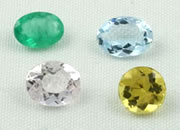 |
"Beryl" is a mineral with several gem varieties based upon color. Green beryl is emerald. Blue is aquamarine. Pink is morganite. Yellow and yellow-green are heliodor. Red is red beryl. Clear is goshenite. |
|
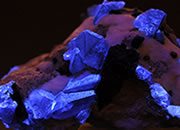 |
"Benitoite" is a rare barium titanium silicate mineral found at a few locations worldwide but in gem quality at only in one location in San Benito County, California. It is the "state gem" of California. |
|
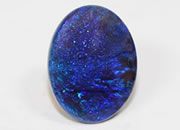 |
The name "black opal" is used for an opal with a black base color. This specimen here has blue play-of-color on a black base. |
|
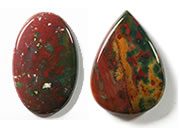 |
Bloodstone is a dark green variety of jasper that displays numerous splashes of red color. These red splashes remind people of blood, and that is how the stone received its name. It has been a popular gem for thousands of years. |
|
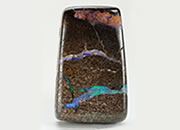 |
"Boulder opal" is a name used for a rough or cut rock material that displays precious opal within its surrounding rock matrix. |
|
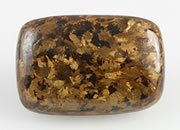 |
Bronzite
A bronze to greenish variety of enstatite with a metallic luster. It is sometimes cut and polished as a gemstone. |
|
 |
Bumblebee
Often called Bumblebee "Agate" or "Jasper," it is instead a rock formed at several volcanic vents in Indonesia. Some specimens reportedly contain arsenic. Not recommended if the stone will be in direct contact with your skin. |
|
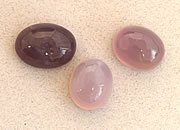 |
Chalcedony
Chalcedony is a name used for any cryptocrystalline quartz such as agate, jasper, petrified wood, chrysoprase, bloodstone, onyx, sard, and carnelian. Some people reserve the name for a blue, unbanded, translucent material. |
|
 |
Charoite is a light lavender to deep purple silicate mineral that has swirling, fibrous, or spotted patterns. It is a rare and relatively new gem material, discovered in Russia in 1978. |
|
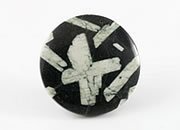 |
Chinese Writing Stone
A black basalt porphyry that contains white phenocrysts of andalusite. Named because the intersecting white crystals remind some people of "Chinese writing." |
|
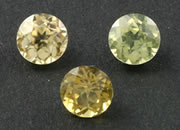 |
Chrysoberyl, a gem unrelated to "beryl," is an "extreme gem." It has a hardness of 8.5, a very high luster, and a high index of refraction. It is sometimes a color-change stone and is best known for its "cat's-eye." |
|
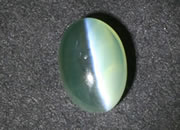 |
Chrysoberyl often contains oriented inclusions that reflect a sharp line of light across the surface of a properly cut stone. This phenomenon is known as a "cat's-eye." |
|
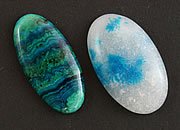 |
Chrysocolla
Chrysocolla is a green to blue-green gem material that forms during the oxidation of copper deposits. The cab on the left is malachite with chrysocolla. The cab on the right is blue chrysocolla in white quartz. |
|
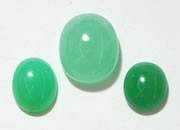 |
Chrysoprase is a yellowish green to bright green variety of chalcedony that is thought to obtain its color from small amounts of nickel. It is a color-variety of cryptocrystalline quartz. |
|
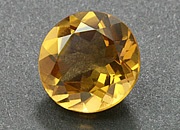 |
Citrine is a transparent variety of quartz that ranges from golden yellow to yellowish orange to golden brown in color. It is usually cut as a faceted stone and is sometimes produced by heat treating amethyst. |
|
 |
Colored diamonds are diamonds that have a noticeable bodycolor when viewed in the face-up position. Gems with superb color can fetch extraordinary prices, often over $1 million per carat. |
|
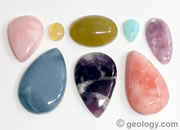 |
Common opal is an opal material that does not exhibit a "play-of-color." Most common opal is common in appearance, but some is spectacular in color or pattern. |
|
|
ADVERTISEMENT
|
|
 |
Coral is a colonial organism that lives in warm, shallow marine waters and often develops reefs. It is a hard calcium carbonate material that can be cut or carved and polished into beautiful organic gems. |
|
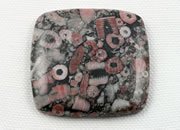 |
Crinoids are organisms that once lived on the ocean floor. They looked like a plant but were actually an invertebrate animal. Their fossils can be found in limestone that can often be used to produce interesting gems. |
|
 |
Crystal opal is a term used for transparent-to-translucent opal material that has a play-of-color within the stone. |
|
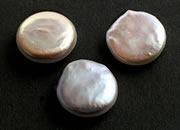 |
Cultured pearls are produced by placing small "seeds" of shell material within a live freshwater mussel. The mussel coats the seed with successive layers of nacre to form a pearl. They are produced in a variety of shapes. |
|
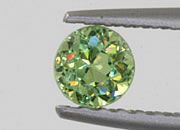 |
Demantoid is a calcium-rich garnet. It has the highest dispersion (ability to separate white light into colors of the spectrum) of any gemstone - higher than diamond. This gives demantoid an exceptional "fire." |
|
 |
The most popular gemstone and hardest natural material. A nearly colorless diamond is set in most engagement rings sold in the United States. The custom of giving an engagement diamond is spreading to other countries. |
|
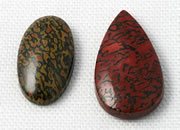 |
Dinosaur bone is often petrified (fossilized by being infilled and replaced by quartz). The quartz can be very colorful. When the petrification is thorough, the material can be cut and polished into attractive gems. |
|
 |
Diopside is a magnesium, calcium silicate mineral. It often contains traces of chromium that cause a vivid green color. These stones are known as "chrome diopside" and can serve as an alternative gem for emerald. |
|
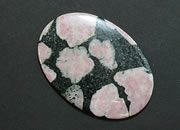 |
Diorite is an igneous rock that can accept a bright polish. It is usually a mixture of dark and light-colored minerals. When these are of attractive colors, the rock can be cut into nice cabochons, beads, and other lapidary items. |
|
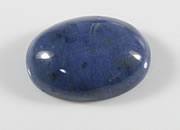 |
Dumortierite
Dumortierite is a dark blue to dark greenish-blue mineral found in metamorphic rocks. It is typically opaque and used to produce cabochons, beads, and tumbled stones. |
|
 |
Emerald is the gemstone name of the mineral beryl when it has a rich green color. It is the most popular stone from the beryl mineral group. Most emeralds have abundant inclusions and fractures. |
|
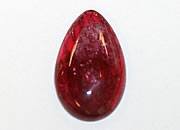 |
Eudialyte
Eudialyte is a rare mineral found in igneous rocks. It serves as a minor ore of zirconium and as a minor gem mineral. It occurs in yellow, brown, and bluish crystals - but bright red specimens are favored as a collector's gem. |
|
 |
Fire agate is a rare gemstone which exhibits a warm iridescence on its botryoidal surfaces. The specimens shown here are from Arizona - one of the few locations in the world where fire agate has been found. |
|
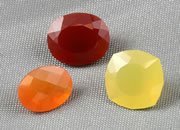 |
A translucent-to-transparent opal with a warm background color of yellow, orange, or red. It may or may not exhibit a "play-of-color." The warm, uniform background color is what defines the stone. |
|
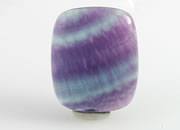 |
A mineral composed of calcium and fluorine (CaF2) that can be colorful and attractive and is often cut as a gemstone. |
|
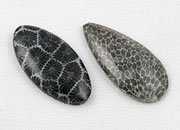 |
Coral and bryozoans are organisms that live in warm, shallow marine waters. They are often fossilized by being infilled and replaced with quartz or calcite. These materials can be polished into attractive gems. |
|
|
ADVERTISEMENT
|
|
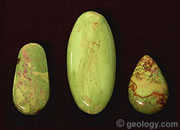 |
Gaspeite is a bright green gem that has become a popular addition to Southwestern-style jewelry, especially as an inlay material. It is also a rare nickel carbonate mineral. |
|
 |
Garnet is the name of a group of minerals with a common crystal structure, but variable composition. Most garnets are red, but the stone also occurs in orange, yellow, purple, green, pink, black, and other colors. |
|
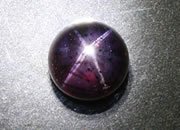 |
Rare specimens of garnet contain a rutile silk that gives them a four- or six-ray star when cut properly. They are highly valued and have been mined commercially only in Idaho, India, and Madagascar. |
|
 |
Gem silica is a rare variety of chalcedony that is colored bluish green by tiny inclusions of chrysocolla or copper salts. It is the most valuable variety of chalcedony. |
|
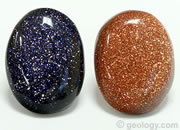 |
A man-made colored glass that contains abundant, flat-faced, highly reflective inclusions that produce a glittery metallic flash when they interact with light. |
|
 |
The colorless to near-colorless variety of beryl is called goshenite. Some of the earliest eyeglasses had lenses made from goshenite because the stone often forms in large, transparent crystals that are free of inclusions. |
|
 |
A man-made glass produced by fusing volcanic ash from the 1980 Mount St. Helens eruption. It is sold in novelty jewelry to tourists visiting the eruption site. |
|
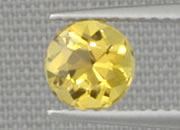 |
Heliodor is the name given to yellow to yellow-green gems of the beryl mineral group. They can be attractive, durable, high-clarity stones with a relatively low price. Surprisingly, they are infrequently seen in jewelry. |
|
 |
Hematite is an iron oxide mineral and the primary ore of iron. It occasionally occurs in a silver metallic form that can be polished to a mirror-bright luster. Cabs cut from hematite are very popular and have a very "weighty" feel. |
|
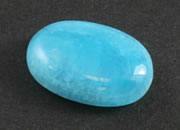 |
Hemimorphite is a zinc silicate mineral that occurs in white, blue, and greenish blue colors. It is a minor ore of zinc. It lacks durability and is used as a collector's gem or in jewelry that will be subject to light wear. |
|
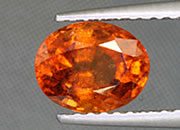 |
Hessonite is a variety of grossular garnet that is rich in iron and manganese. It has an orange to red-orange to reddish brown color and is sometimes called "cinnamon stone." It is occasionally seen in jewelry. |
|
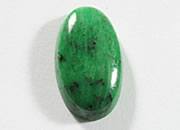 |
Hydrogrossular is a garnet in which hydroxide partially replaces silica. Often an opaque green stone, its nickname is "Transvaal jade" because it looks like jade and is found in the Transvaal area of South Africa. |
|
 |
Iolite is the name given to gem-quality cordierite. It is a strongly pleochroic gem material that, when properly oriented, can produce gemstones with a deep bluish color similar to sapphire and tanzanite. |
|
 |
Iris agate is a finely banded agate with a spectacular display of color when it is cut into thin pieces and illuminated from a direction that sends light through its very thin bands. |
|
 |
An extremely durable material that has been fashioned into gems, sculptures, tools, and weapons for thousands of years. Extremely popular in China. There are two varieties: jadeite and nephrite. |
|
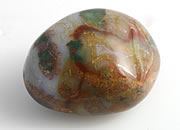 |
Jaspagate
A variety of chalcedony that displays characteristics of both jasper and agate. It has both opaque areas and translucent areas. |
|
 |
Jasper
A variety of opaque chalcedony that is often brightly colored by impurity inclusions. It can be almost any color and is popular as beads, cabochons, and tumbled stones. |
|
 |
Jet is a coal with a uniform texture that can be cut into attractive black gems. It was popular in mourning jewelry of Victorian England. It has a low specific gravity, which makes a long strand of beads lighter than expected. |
|
 |
K2 and K2 Granite are names used for an azurite granite found at the base of K2, the world's second-highest mountain. It cuts beautiful cabs and polishes to a bright luster. Some people call it K2 Jasper, but that is incorrect. |
|
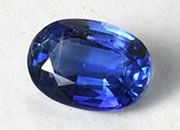 |
A metamorphic mineral that occurs in beautiful hues of blue and green. It has perfect cleavage and has a hardness of 4.5 in one direction, 5.5 in another, making it best used in items that will not be subjected to wear. |
|
 |
A gemstone from the plagioclase feldspar family that produces flashes of iridescent blue, green, yellow, orange, or red when moved under incident light. This luster is known as labradorescence. |
|
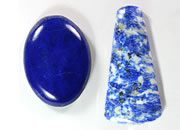 |
A blue metamorphic rock that has been used as a gemstone for over 6000 years and as a pigment for at least 1000 years. It is a popular gem material used for cabochons, beads, inlay, and small sculptures. |
|
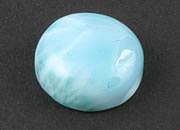 |
Larimar
Larimar is a rare blue variety of pectolite found only in the Dominican Republic. It is popular because of its delicate blue color. It must be used with care because it is fragile and will fade with long exposure to bright light. |
|
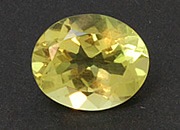 |
Lemon quartz is a yellow variety of quartz that is transparent to translucent. It is often cut as a faceted stone or cut en cabochon. |
|
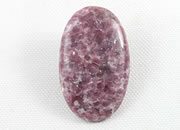 |
A lithium-rich mica with a rose to lilac color and an aventurescent luster that is sometimes used to make cabochons, tumbled stones, and other lapidary projects. |
|
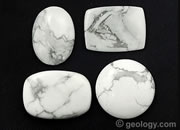 |
A magnesium carbonate mineral that is often confused with howlite due to their similar appearance. Magnesite can be easily dyed, and specimens dyed a blue color are used as imitation turquoise. |
|
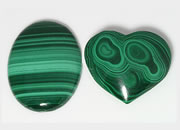 |
Malachite is a heavy, opaque, green gemstone marked with bands and swirls. It is a copper carbonate mineral that is soft and cleaves easily. It is best used in items that will not be subjected to abrasion or impact. |
|
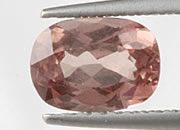 |
Malaya is a pink to pinkish brown or reddish variety of garnet. Compositionally, it is a mixture of pyrope, almandine, and spessartine. It is occasionally seen in jewelry. |
|
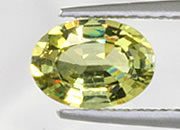 |
Mali is a yellow to yellowish green variety of garnet, named after the African country of Mali. It is a mixture of grossular and andradite that is occasionally seen in jewelry. |
|























































































